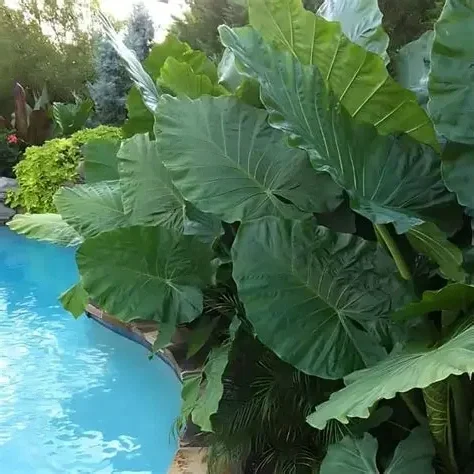Elephant Ears: Tropical Addition for Landscape Design
Elephant Ear Leaves
Elephant ears (Colocasia, Alocasia, and Xanthosoma species) are beloved for their massive, heart- or arrow-shaped leaves that bring bold texture and lush greenery to gardens across the South. At Professional Landscape Design, we use these tropical perennials to create instant impact—whether flanking entryways, softening hardscapes, or adding height and movement to water features. With varieties ranging from velvety black to lime green and even speckled or striped, elephant ears offer endless design possibilities.
Growth Rate & Care
These plants thrive in full to partial sun, depending on the variety, and prefer rich, moist, well-drained soil. Many types love boggy conditions and can even tolerate shallow standing water, making them ideal for rain gardens or pond edges. For best results, plant tubers in spring once soil temperatures reach 65–70°F, and space them generously—smaller varieties need 2 feet, while larger types may require 4 feet or more. Fertilize every 2–3 weeks during the growing season with a high-nitrogen formula to support their fast growth and oversized foliage.
Watering is key: elephant ears are heavy drinkers, especially in containers or full sun. Keep soil consistently moist but not soggy, and avoid letting it dry out completely. Indoors, they prefer bright, indirect light and high humidity—mist regularly or use a humidifier to prevent leaf browning. In colder zones, dig up tubers before the first frost, let them dry, and store in a cool, dark place until spring. Container-grown plants can be overwintered indoors with reduced watering and no fertilizer.
While generally pest-resistant, elephant ears can occasionally face issues like fungal leaf blight or root rot if overwatered. Aphids and spider mites may appear in dry indoor conditions, so inspect regularly and maintain airflow. Warning: All parts of the plant contain calcium oxalate crystals, which are toxic if ingested—so plant with care around pets and children. Despite this, elephant ears are deer-resistant and offer ecological value by attracting pollinators and providing shelter for small wildlife.
Elephant Ears Next to Pool, Pollinator-Attractor
Landscape Design
At Professional Landscape Design, we love pairing elephant ears with Hibiscus, coleus, Bird-of-Paradise, and ornamental grasses for layered texture and color. Whether you're designing a tropical retreat or adding drama to a shaded corner, these plants deliver bold beauty with relatively simple care. Ready to go big with your garden? Let’s bring the resort to your backyard.

